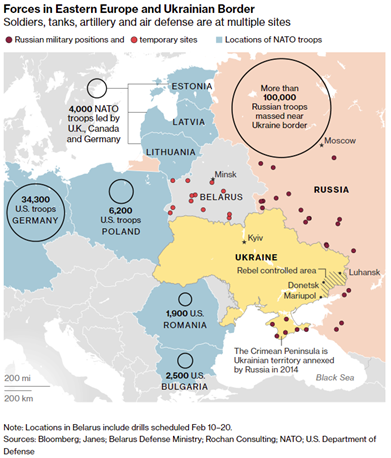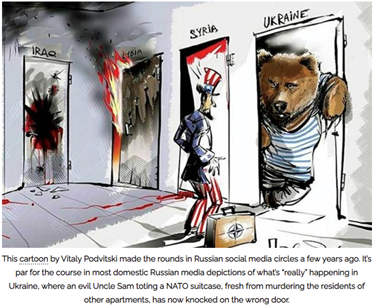Geopolitics: Ukraine
February 11, 2022 •OneAscent

What is happening currently?
Standing in stark contrast to the message of unity associated with the ongoing Winter Olympics, tensions in eastern Europe continue to rise as Russia has amassed more than 100,000 troops, along with tanks and artillery, near the border of Ukraine (see image below). Although the accumulation of troops began months ago, the situation continues to escalate as diplomatic discussions between Russia and members of the North Atlantic Treaty Organization (NATO), an alliance of 30 member states across North America and Europe, have largely fallen flat over the past few weeks.[1]

What is this happening?
Russia has expressed concern over the potential for the inclusion of Eastern European countries, such as Ukraine and Georgia which were formerly part of the Soviet Union, in NATO. NATO was formed shortly after the second World War with the goal of ensuring freedom and security for member countries, particularly those in Europe that were most devastated by the War.[2] In the last 25 years, former Soviet Union countries like Estonia, Latvia, and Lithuania have joined NATO, likely to the chagrin of Russian leaders with hopes of one day reestablishing the union. Ukraine is one of the most strategically important former Soviet states given its reserves of natural gas as well as the pipelines from Russia to Europe that run through it.
Russian President Vladimir Putin is demanding that Ukraine be barred from ever joining NATO and that the US and Western allies reduce their military presence across Central and Eastern Europe, viewing those developments as creeping too close to Russian borders. Ukraine and NATO members argue that Ukraine should be eligible to join, especially given that Russia invaded the country in 2014 and annexed the Crimean Peninsula, and that the defensive posture in Central Europe is warranted to protect against future Russian aggression.[3]
Further complicating the issue, Russia and China have grown closer of late. In fact, as the opening ceremonies of the Winter Olympics kicked off last week, China and Russia issued a joint statement declaring that they intend to work in a “no limits” partnership across a wide variety of issues in an effort to effectively compete with the US. In addition, each stated that they support the other in their respective territory stand-offs with the West (Russia with Ukraine and China with Taiwan). Lastly, Putin used the opportunity to announce a new natural gas deal with China, further diversifying energy exports away from Europe.[4]
Will Russia invade?
It is uncertain whether President Putin has amassed the troop buildup with the intention of invading or if he is simply using Ukraine as a negotiating tool to get his desired outcome. Opinions on the matter differ dramatically depending on the source, with Russia denying accusations that they are planning an invasion, and the US and Western allies indicating that an invasion may be imminent. In fact, some members of the US intelligence community have stated that they believe Russia is planning a “false flag” operation, staging a fake attack on their troops and blaming Ukraine, in an effort to justify the invasion they have planned all along.[5]

One development that is somewhat concerning, at least in our opinion, is the apparent effort being made by both sides to control the media narrative related to the dispute. Russian media continues to paint the US, along with NATO allies to some extent, as the aggressor in this confrontation, seemingly in an effort to mobilize opinion on the home front in support of the invasion (although this example is from a few years ago, see cartoon at right as an example).[6] Additionally, Russian officials have attempted to paint Ukraine as a “hotbed of Nazis” to the Russian people.[7] Efforts are also being made by the US and Western leaders to frame Russia as the sole aggressor, making it harder for either side to back down without losing perceived credibility with citizens at home.
The standoff has understandably set off a flurry of diplomatic efforts. Some of those efforts, including French President Macron’s recent meeting with Putin, include trying to de-escalate the situation and to find a peaceful solution. On the flip side, German and US leadership met at the same time as the Macron/Putin meeting to discuss potential repercussions of a Russian invasion, including potentially scrapping the completion of the Nord Stream 2 gas pipeline, a multibillion-dollar project intended to deliver additional Russian natural gas to Germany.[8] In spite of the current impasse, diplomatic efforts continue, so there is still an opportunity for a peaceful resolution.
If a Russian invasion of Ukraine does occur, it will likely result in casualties on both sides at a minimum. However, the extent of the damage, at least from a humanitarian standpoint, likely hinges on whether the US and other NATO members actively come to Ukraine’s aid with their own forces. If the NATO response comes primarily in the way of additional economic sanctions, tensions will rise but we expect a return to relative normal after a period of time, so long as Russian aggression does not continue (similar to the Crimean annexation in 2014, a relatively short-lived military engagement). However, if the US and Western allies step in with their own forces, we believe this has the potential to escalate beyond a regional dispute and to threaten geopolitical stability more broadly.
What does all of this mean from an economic and market perspective?
To paraphrase a quote attributed to billionaire investor George Soros when asked about his prediction for a situation, he replied, “I’m not predicting it, I’m observing it."[9] As with any geopolitical issue, it is difficult to predict exactly how the situation in Ukraine will play out. We choose instead to focus on carefully observing developments and leaning into, or out of, different risks and opportunities in portfolios as warranted.
However, there is one area of the market that has already been impacted by developments in Ukraine – energy. It is important to remember as this situation evolves that Russia currently provides about 40 percent of the European Union’s natural gas needs. That reliance makes it possible for Russia to threaten to cut supply to Europe as a negotiating tool. As a result, continued escalation may further exacerbate energy price spikes across the EU. Lastly, European reliance on Russian energy could also impact how forcefully different EU countries react if an invasion occurs. European unity could be tested if countries more reliant upon cheap Russian gas, such as Germany, choose less severe action than those with more diversified energy supply chains.[10]
We believe that the potential outcomes in this complex situation range broadly, from essentially a minor economic and market event (assuming a peaceful resolution is reached in the near-term) to a more destabilizing event if multiple countries are pulled into a conflict. As a result, we intend to pay close attention to events to determine what, if any, portfolio changes are needed as the situation develops.
[1] Source: Mapping Russia’s Military Buildup Near Ukraine, Rising Tensions in Europe (bloomberg.com)
[2] Source: NATO - Declassified: A short history of NATO
[3] Source: Why Does Russia Want Ukraine? Make Sense of News About Risk of War - Bloomberg
[4] Source: China, Russia partner up against West at Olympics summit | Reuters
[5] Source: US alleges Russia planning false flag operation against Ukraine using 'graphic' video - CNNPolitics
[6] Source: Epsilon Theory: Getting to War - Epsilon Theory
[7] Source: As Russia threatens Ukraine, the U.S. 'pre-bunks' Russian propaganda : NPR
[8] Source: Biden Says Natural Gas Pipeline Will 'End' If Russia Invades Ukraine - Bloomberg
[9] Source: George Soros says he expects hard landing for China economy: Bloomberg | Reuters
[10] Source: Europe seeks natural gas supplies as conflict with Russia over Ukraine looms - The Washington Post
Download PDF Version
Past performance may not be representative of future results. All investments are subject to loss. Forecasts regarding the market or economy are subject to a wide range of possible outcomes. The views presented in this market update may prove to be inaccurate for a variety of factors. These views are as of the date listed above and are subject to change based on changes in fundamental economic or market-related data. Please contact your Financial Advisor in order to complete an updated risk assessment to ensure that your investment allocation is appropriate.


